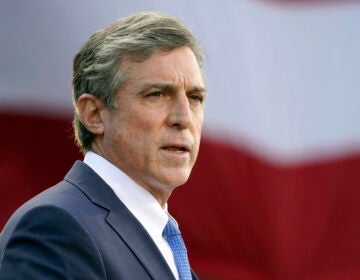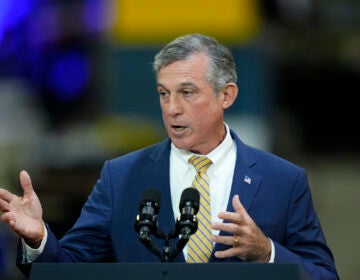Gov. Carney outlines $7.2 billion spending plan in Delaware
The proposal for fiscal 2024 stresses new investments in education, housing, and the environment, plus significant pay raises for many state employees.

File photo: Delaware Gov. John Carney speaks at the Major Joseph R. ''Beau'' Biden III National Guard/Reserve Center in New Castle, Del., Jan. 19, 2021. (AP Photo/Evan Vucci, File)
Delaware’s government would spend $7.2 billion next fiscal year — prioritizing raises for teachers and other education initiatives, adding affordable housing, creating jobs and improving roads, and investing in clean water and other environmental programs — under a budget Gov. John Carney proposed Thursday.
Carney, entering his seventh year in office, used his budget presentation to stress that revenues are strong, aided by an infusion of federal pandemic relief money for projects outside of the budget process.
Yet the governor, whose tenure ends in January 2025, stressed that he wants to be prudent because that money won’t be available in future years. To that end, he wants to add $18.9 million to a budget stabilization fund he created in his first term, which would raise its value to $421.5 million. Those dollars are coupled with a so-called “rainy day” fund from setting aside some 5% of revenues annually.
“When you consider the two of them together, you’re close to $1 billion of reserves,’’ Carney said. “When that revenue goes south on us, we will have that reserve account to go to so that we don’t have to raise taxes or cut spending like we have in the past.”
The biggest component of the budget is the $5.5 billion operating budget for payroll and other ongoing expenses — 7.4% higher than the current year.
The operating plan, also known as the general fund budget, includes $149.7 million for raises of 3% to 9% for state employees, with teachers and lower-paid workers getting the biggest boost. All full-time employees in the state merit system would get paid a minimum of $15 an hour.
“We’re competing with the Amazons and the McDonald’s of the world when it comes to employees, ‘’ said budget director Cerron Cade, who joined the governor at the briefing Thursday morning in Dover. He said the higher salaries would help fill vacancies.
Elsewhere in education, Carney wants to spend $30 million for mental health services for elementary and middle school students.
He’d provide $7.1 million more next year for scholarships at the University of Delaware, Delaware State University and Delaware Technical Community College, for a total of $39.3 million.
The budget also provides $101.5 million more for housing.
One component is a so-called “catalyst fund’’ that provides construction loans for the redevelopment of vacant or blighted properties.
Another is an “accelerator fund” that gives incentives to developers who set aside lower-cost units in a project where rents will be charged at market rates.
“Is is enough?’’ Carney asked rhetorically. “It’s not because it’s very, very expensive, but it will give nonprofit agencies across our state that are working on this additional resources so that we can create more units.”
There’s also cash to support a tenant’s right to representation in eviction proceedings.
Other operating budget highlights include:
- $18 million to a fund that provides low-interest loans and grants to municipalities, private organizations, nonprofit organizations, and private individuals for projects to improve water quality.
- $25 million toward the Delaware Strategic Fund fund that provides and grants to attract and retain larger businesses.
- $20 million to preserve farmland and open space.
- $25 million toward tax breaks, which take effect for next year’s tax returns, for lower- and middle-income earners. The main component is a 75% increase in the standard deduction to $5,700 for individual filers.
Carney says he thought about proposing other tax breaks, but decided against doing so.
“When I compared doing another smaller tax cut opposite a higher raise for our teachers or for state employees, it felt like we’d get a better bang for our taxpayer buck in doing it and raising the teacher salary, then a tax additional tax cut that probably would be not very meaningful for most folks.”
The second largest part of the spending plan is the $1.3 billion capital improvements budget for construction and renovation projects. Highlights include:
- $322 million in work on roads and highways.
- $192 million for K-12 schools.
- $116 million for court, police, and prison facilities.
- $60 million for deferred maintenance, capital improvements, and technology upgrades at the three colleges.
The next steps in the budget process are hearings starting in February of the legislative Joint Finance Committee and Bond Bill Committee.
Lawmakers can make changes, usually in consultation with the governor’s office, and by law the budget must be passed by June 30 for the fiscal year that starts the next day.
WHYY is your source for fact-based, in-depth journalism and information. As a nonprofit organization, we rely on financial support from readers like you. Please give today.







